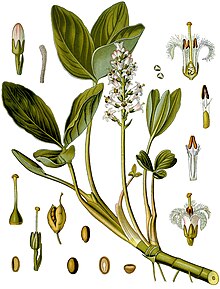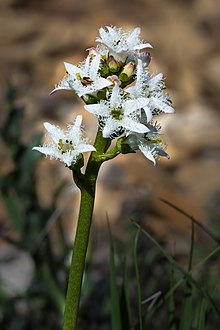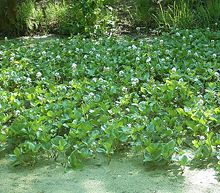Fever clover
| Fever clover | ||||||||||||
|---|---|---|---|---|---|---|---|---|---|---|---|---|

Fever clover ( Menyanthes trifoliata ) |
||||||||||||
| Systematics | ||||||||||||
|
||||||||||||
| Scientific name of the genus | ||||||||||||
| Menyanthes | ||||||||||||
| L. | ||||||||||||
| Scientific name of the species | ||||||||||||
| Menyanthes trifoliata | ||||||||||||
| L. |
The fever clover or bitter clover ( Menyanthes trifoliata ) is the only plant species of the monotypical genus Menyanthes in the family of the fever clover plants (Menyanthaceae). This marsh or water plant is widespread in the northern hemisphere .
description
Vegetative characteristics
The fever clover grows as a perennial , herbaceous plant that reaches heights of up to 30 cm. The foliage leaves stand at the nodes of the creeping, roughly finger-thick rhizomes . The leaves are divided into a 12 to 20 (rarely up to 30) cm long, widened petiole close to the base and a three-pinnate leaf blade . The three almost sessile leaflets are elliptical and have entire margins.
Generative characteristics
In the leaf axils stand the upright, racemose inflorescences on a 20 to 30 cm long, leafless stem . The hermaphroditic flowers are radial symmetry and five-fold with a double flower envelope . The five small, green sepals are fused at the base. The five narrow petals are up to 1.5 cm long and often bright pink on the outside at the beginning, so that the budding inflorescences appear pink overall. Inside, the petals are covered by many strong, long fringed hairs and are very light pink to almost pure white in color. When in full bloom, they are slightly rolled back. The five purple stamens , alternating with the petals, open lengthways, spread the pollen sacs like an arrow and release orange pollen . Two carpels are a top permanent ovary adherent having a thread-like stylus having two scars branches bears. This species is heterostyle (differently tactile ).
A two-lobed capsule fruit is formed, which has a diameter of 6 to 7 mm. It contains several smooth, brown, egg-shaped seeds that are 2 to 2.5 mm in diameter.
The species has chromosome number 2n = 54.
ecology
In Central Europe the flowering period extends from the end of April to June, the fruit ripening from June to July.
As a water plant, the fever clover is a water root or a marsh plant. It has the following adaptations to the swamp location: Stems and leaf stalks are hollow and are used for ventilation and buoyancy in the oxygen-poor swamp location. The tannin content is up to 7%, which counteracts the formation of rot.
In terms of flower biology, they are homogamous "large funnel flowers". The fringes of the petals are morphologically hair-shaped emergences that serve as barrier hairs for small insects and at the same time increase the visual effect. The nectar secretion takes place at the base of the ovary . The flowers respond to touch and temperature stimuli. Pollinators are bumblebees and other bees . The capsule fruits act as wind spreaders. The seeds are subject to swimming dispersal.
The fever clover is a pioneer plant that penetrates into shallow water , contributes to silting up and thus prepares the habitat for other species, by which it is eventually displaced. Brown sedge ( Carex nigra ), swamp blood-eye ( Potentilla palustris ), swamp violet ( Viola palustris ) and narrow-leaved cottongrass ( Eriophorum angustifolium ) are frequent companions .
Occurrence and endangerment
The fever clover has a wide circumpolar distribution in the northern hemisphere and is considered an arctic-Nordic floral element. From the lowlands to subalpine heights, it grows terrestrially in wetlands and half submerged, swimming into the shallow water. Typical locations are spring swamps of rivers , swamp forests , intermediate bogs and the edges of raised bogs. It thrives especially in intermoor and Schlenken communities (Scheuchzerietalia palustris).
In the Allgäu Alps, it rises in the Hochalpsee on the Widderstein in the Kleiner Walsertal up to 2000 m above sea level.
However, since many of these natural sites have been drained, the fever clover is considered endangered in Germany . According to the Federal Species Protection Ordinance, it is under special protection and may not be taken from nature without permission.
The Loki Schmidt Foundation named the fever clover " Flower of the Year " 2020.
Systematics
The genus Menyanthes was established in 1753 by Carl von Linné with the type species Menyanthes trifoliata in Species Plantarum . A synonym for Menyanthes L. is Limnanthemum SGGmel. Its botanical name Menyanthes trifoliata (from Greek : directly translated "trifoliate monthly flower") received this type because of their typical three sub-sheets and because of the previously held belief that plants would bloom for only one month a year.
pharmacology
The dried leaves of the flowering plant are said to have healing properties.
Active ingredients are: bitter-tasting secoiridoid glycosides such as dihydrofoliamenthin and iridoid glycosides such as loganin ; Monoterpene alkaloids such as gentianine are probably only formed when the plant is processed; Flavonoids , coumarins , phenol carboxylic acids and tannins .
As a bitter agent, the drug promotes the secretion of saliva and gastric juice and is used accordingly for loss of appetite and digestive disorders as well as for bloating or flatulence. Extracts are also occasionally found in bitter herbal liqueurs and schnapps. Clover leaves are mainly used in tea blends.
The earlier usual intake against fever cannot be understood due to the ingredients.
Today's preparation instructions are listed in the Homeopathic Pharmacopoeia (HAB) . In the 19th century, the freshly squeezed juice of the "whole plant that was just about to bloom" was mixed with the same amount of spirit .
toxicology
All parts of the plant are hardly poisonous. The main active ingredients are alkaloids such as gentianine .
As a result, unpleasant headaches can occur. Large doses can cause vomiting and diarrhea, but this is only to be expected if the old folk remedy is misused.
swell
- Ting-nung Ho, Robert Ornduff: Menyanthaceae. In: Wu Zheng-yi, Peter H. Raven (Ed.): Flora of China . Volume 16: Gentianaceae through Boraginaceae . Science Press / Missouri Botanical Garden Press, Beijing / St. Louis 1995, ISBN 0-915279-33-9 , pp. 140 (English). , PDF file , online (sections Description and Distribution).
- Mohammad Qaiser: Flora of West Pakistan. 111: Menyanthaceae. Stewart Herbarium, Rawalpindi 1977, online (Description section).
- Ruprecht Düll , Herfried Kutzelnigg : Pocket dictionary of plants in Germany and neighboring countries. The most common Central European species in portrait . 7th, corrected and enlarged edition. Quelle & Meyer, Wiebelsheim 2011, ISBN 978-3-494-01424-1 .
- Lutz Roth , Max Daunderer , Kurt Kormann : Poison Plants - Plant Poisons. Poisonous plants from AZ. Emergency assistance. Occurrence. Effect. Therapy. Allergic and phototoxic reactions . 4th edition. Nikol, Hamburg 2000, ISBN 3-933203-31-7 (reprint from 1994).
- Ingrid Schönfelder, Peter Schönfelder : The new manual of medicinal plants. Special edition. Franckh-Kosmos, Stuttgart 2011, ISBN 978-3-440-12932-6 .
Individual evidence
- ↑ a b Erich Oberdorfer : Plant-sociological excursion flora for Germany and neighboring areas . 8th edition. Stuttgart, Verlag Eugen Ulmer, 2001. Page 750. ISBN 3-8001-3131-5
- ↑ Fever clover. In: FloraWeb.de.
- ↑ Erhard Dörr, Wolfgang Lippert : Flora of the Allgäu and its surroundings. Volume 2, IHW, Eching 2004, ISBN 3-930167-61-1 , p. 353.
- ↑ Carl von Linné: Species Plantarum. Volume 1, Lars Salvius, Stockholm 1753, p. 145, digitized
- ^ Menyanthes at Tropicos.org. Missouri Botanical Garden, St. Louis
- ↑ awl.ch: Menyanthes trifoliata - fever clover
- ↑ Samuel Hahnemann: Pure drug theory . tape 5 . Dresden, Leipzig 1826, p. 14-40 ( Bitter clover (Menyanthes trifoliata.) At Zeno.org .).
- ↑ a b Lutz Roth, Max Daunderer, Kurt Kormann: Toxic Plants - Plant Poisons. Occurrence, effect, therapy, allergic and phototoxic reactions. With a special section about poisonous animals. 6th, revised edition, special edition. Nikol, Hamburg 2012, ISBN 978-3-86820-009-6 .
Web links
- The fever clover as a medicinal plant.
- Menyanthes trifoliata L., fever clover. In: FloraWeb.de.
- Fever clover . In: BiolFlor, the database of biological-ecological characteristics of the flora of Germany.
- Menyanthes trifoliata L. In: Info Flora , the national data and information center for Swiss flora .
- Distribution in the northern hemisphere from: Eric Hultén, Magnus Fries: Atlas of North European vascular plants. 1986, ISBN 3-87429-263-0 at Den virtuella floran. (swedish).
- Profile of the Art. ( Memento from November 25, 2003 in the Internet Archive )
- Photos leaves, flowers





